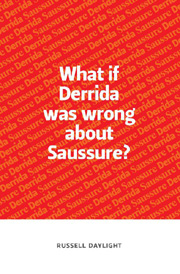Book contents
- Frontmatter
- Contents
- Acknowledgements
- Abbreviations and Textual Notes
- Introduction
- 1 Classical Semiology
- 2 The Originality of Saussure
- 3 The Concept of the Sign
- 4 Writing, Speech, and the Voice
- 5 The Sign as Representation
- 6 Linguistic Identity
- 7 The Sign and Time
- 8 The Horizon of Language
- Conclusion
- List of Works by Derrida and Saussure
- References
- Index
1 - Classical Semiology
Published online by Cambridge University Press: 12 September 2012
- Frontmatter
- Contents
- Acknowledgements
- Abbreviations and Textual Notes
- Introduction
- 1 Classical Semiology
- 2 The Originality of Saussure
- 3 The Concept of the Sign
- 4 Writing, Speech, and the Voice
- 5 The Sign as Representation
- 6 Linguistic Identity
- 7 The Sign and Time
- 8 The Horizon of Language
- Conclusion
- List of Works by Derrida and Saussure
- References
- Index
Summary
Derrida often uses the epithet ‘classical’. It appears most often in his expression ‘classical metaphysics’ (S&P: 51; GS&P: 166), but also in ‘the classical concept of writing’ (SEC: 9), in ‘the classical opposition’ between speech and writing (SEC: 21), and in how signs can be eliminated ‘in the classical manner’ (S&P: 51). Derrida first uses the expression ‘classical semiology’ in ‘Différance’, to name the metaphysical system in which a sign takes the place of the thing in its absence:
The sign represents the present in its absence. It takes the place of the present. When we cannot grasp or show the thing, state the present, the being-present, when the present cannot be presented, we signify, we go through the detour of the sign. … According to this classical semiology, the substitution of the sign for the thing itself is both secondary and provisional: secondary due to an original and lost presence from which the sign thus derives; provisional as concerns this final and missing presence toward which the sign in this sense is a movement of mediation. (Diff: 9)
Classical semiology is thus the semiology of presence, and the semiology of the epoch of classical metaphysics. Within this epoch, Derrida states, ‘the original and essential link to the phonè has never been broken. It would be easy enough to demonstrate this and I shall attempt such a demonstration later’ (OG: 11).
- Type
- Chapter
- Information
- What if Derrida was wrong about Saussure? , pp. 19 - 32Publisher: Edinburgh University PressPrint publication year: 2011



